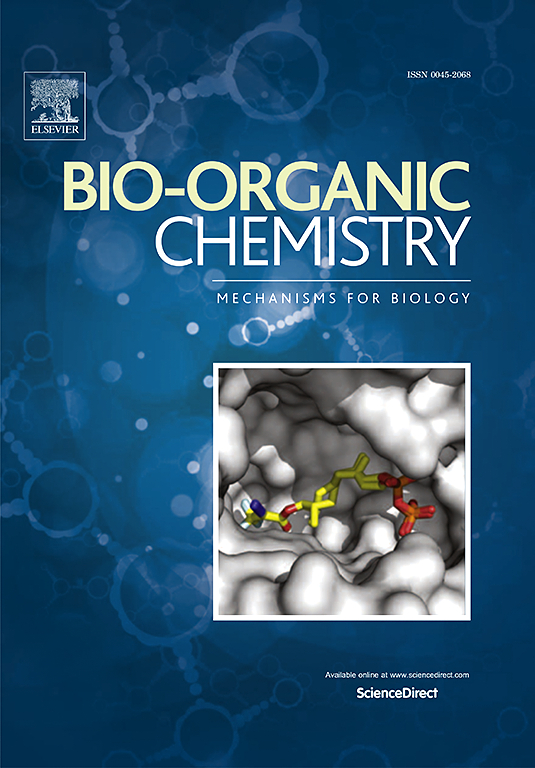Exploring the antivirulence mechanisms of ZnO-PEG-quercetin nanoparticles: Biofilm disruption, attenuation of virulent factors, and cell invasion suppression against pathogenic Pseudomonas aeruginosa
IF 4.5
2区 医学
Q1 BIOCHEMISTRY & MOLECULAR BIOLOGY
引用次数: 0
Abstract
The dense biofilm architecture and efflux pump activity play critical roles in Pseudomonas aeruginosa infections by hindering the accumulation and long-term efficacy of antibacterial agents within bacterial cells. The development of engineered nanoparticles capable of penetrating the polysaccharide matrix of biofilms represents a promising strategy for addressing bacterial infections. This is the first report on the synthesis of quercetin-functionalized PEGylated ZnO nanoparticles (ZnO-PEG-QUE NPs) and the evaluation of their anti-biofilm activity against pathogenic strains of P. aeruginosa. The synthesized NPs exhibited spherical shapes with an average size of 59.52 nm. ZnO-PEG-QUE NPs demonstrated biofilm inhibitory levels between 49 % and 67 %, and significantly reduced the production of total exopolysaccharides, alginate, and pellicle by 64.61 %–71.69 %, 30.47 %–45.36 %, and 24.22 %–85.97 %, respectively. ZnO-PEG-QUE NPs not only inhibited early-stage biofilm formation but also disrupted mature biofilms, indicating a dual mode of action against both biofilm development and persistence. Based on our findings, ZnO-PEG-QUE NPs effectively eradicated mature biofilms by 67.2 %–72 % and significantly reduced the metabolic activity and viable cells of preformed biofilms to 34.12 %–55.57 % and 6.25–8.15 log CFU, respectively. Electron and fluorescence microscopy analyses also confirmed the antibiofilm potential of ZnO-PEG-QUE NPs. Furthermore, bacterial adhesion and invasion to HDF cells were significantly diminished in the NP-treated groups. The attenuation of efflux pump activity in the NP-treated strains was confirmed using the EtBr-agar cartwheel assay. Taken together, these findings highlight the therapeutic potential of ZnO-PEG-QUE NPs as a novel and effective strategy to combat biofilm-associated infections, warranting further investigation in preclinical models.

探讨zno - peg -槲皮素纳米颗粒的抗毒机制:破坏生物膜、减弱毒力因子和抑制致病性铜绿假单胞菌的细胞侵袭
致密的生物膜结构和外排泵活性在铜绿假单胞菌感染中发挥关键作用,阻碍了抗菌药物在细菌细胞内的积累和长期疗效。能够穿透生物膜的多糖基质的工程纳米颗粒的发展代表了解决细菌感染的一个有前途的策略。本文首次报道了槲皮素功能化聚乙二醇化ZnO纳米颗粒(ZnO- peg - que NPs)的合成及其对铜绿假单胞菌病原菌的抗生物膜活性评价。合成的纳米粒子呈球形,平均尺寸为59.52 nm。ZnO-PEG-QUE NPs的生物膜抑制水平在49% ~ 67%之间,并显著降低了总外多糖、海藻酸盐和膜的产量,分别为64.61% ~ 71.69%、30.47% ~ 45.36%和24.22% ~ 85.97%。ZnO-PEG-QUE NPs不仅可以抑制早期生物膜的形成,还可以破坏成熟的生物膜,表明其对生物膜的发育和持久性具有双重作用。结果表明,ZnO-PEG-QUE NPs对成熟生物膜的有效根除率为67.2% ~ 72%,并显著降低了预成型生物膜的代谢活性和活细胞,分别为34.12% ~ 55.57%和6.25 ~ 8.15 log CFU。电子显微镜和荧光显微镜分析也证实了ZnO-PEG-QUE NPs的抗菌膜潜能。此外,np处理组细菌对HDF细胞的粘附和侵袭明显减少。利用etbr -琼脂轮实验证实了np处理菌株外排泵活性的衰减。总之,这些发现突出了ZnO-PEG-QUE NPs作为对抗生物膜相关感染的新颖有效策略的治疗潜力,值得在临床前模型中进一步研究。
本文章由计算机程序翻译,如有差异,请以英文原文为准。
求助全文
约1分钟内获得全文
求助全文
来源期刊

Bioorganic Chemistry
生物-生化与分子生物学
CiteScore
9.70
自引率
3.90%
发文量
679
审稿时长
31 days
期刊介绍:
Bioorganic Chemistry publishes research that addresses biological questions at the molecular level, using organic chemistry and principles of physical organic chemistry. The scope of the journal covers a range of topics at the organic chemistry-biology interface, including: enzyme catalysis, biotransformation and enzyme inhibition; nucleic acids chemistry; medicinal chemistry; natural product chemistry, natural product synthesis and natural product biosynthesis; antimicrobial agents; lipid and peptide chemistry; biophysical chemistry; biological probes; bio-orthogonal chemistry and biomimetic chemistry.
For manuscripts dealing with synthetic bioactive compounds, the Journal requires that the molecular target of the compounds described must be known, and must be demonstrated experimentally in the manuscript. For studies involving natural products, if the molecular target is unknown, some data beyond simple cell-based toxicity studies to provide insight into the mechanism of action is required. Studies supported by molecular docking are welcome, but must be supported by experimental data. The Journal does not consider manuscripts that are purely theoretical or computational in nature.
The Journal publishes regular articles, short communications and reviews. Reviews are normally invited by Editors or Editorial Board members. Authors of unsolicited reviews should first contact an Editor or Editorial Board member to determine whether the proposed article is within the scope of the Journal.
 求助内容:
求助内容: 应助结果提醒方式:
应助结果提醒方式:


